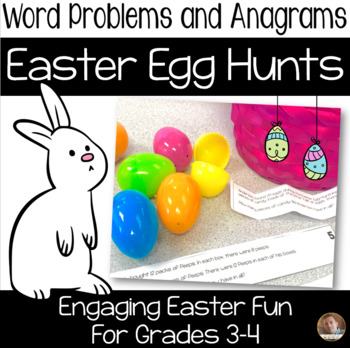Easter Egg Hunt - Anagrams and Word Problems (2 Egg Hunts included)- Grades 3-4
Mr Mault's Marketplace
18.5k Followers
Grade Levels
3rd - 4th
Subjects
Resource Type
Standards
CCSS3.OA.A.3
CCSS3.OA.A.4
CCSS3.OA.B.6
CCSS3.OA.C.7
CCSS4.OA.A.1
Formats Included
- PDF
Pages
12 pages
Mr Mault's Marketplace
18.5k Followers
Description
Easter Egg Hunts are such a fun part of being an elementary teacher! What's even better? A fun and EDUCATIONAL Easter Egg Hunt! Included in this pack are two different Easter Egg Hunts.
For both Egg Hunts, you will need plastic Easter Eggs. It's totally up to you how many colors you want, but you should have different colors for each different group.
So, if you want 6 groups, you will need 6 different colored eggs.
You will need at least 6 of the same color eggs.
I used:
Green
Blue
Pink
Orange
Yellow
Purple
For the first Easter Egg Hunt, you will have students solving multi-step word problems. Place the word problems inside of the Easter Eggs and hide them in your classroom. You will group students and place them into color groups. The groups will find their eggs and begin solving the problems. Students will record their answers and once they finish with all of their problems, they will receive a prize if they get them all correct.
Later on in the day, I am going to have ANOTHER Easter Egg Hunt. This one is ELA based and includes anagrams. The same color scheme can be used as the first egg hunt. During this hunt, you will place letters inside of the eggs. For example, in one set of eggs, you will place the letters E-A-S-T-E-R. You can give students a large piece of poster paper. After they go find their eggs, the group will place their letters across the top of their poster. They will then work as a team to make as many words as they can using the letters they found in their hunt. After a period of time, students will be stopped and points will be counted up. Students receive 1 point for every letter from each word they created. Again, students will receive a prize for the high score.
I hope this helps you makes your spring just a little more fun and helps you with planning before spring break!
Enjoy!
-Dan
For both Egg Hunts, you will need plastic Easter Eggs. It's totally up to you how many colors you want, but you should have different colors for each different group.
So, if you want 6 groups, you will need 6 different colored eggs.
You will need at least 6 of the same color eggs.
I used:
Green
Blue
Pink
Orange
Yellow
Purple
For the first Easter Egg Hunt, you will have students solving multi-step word problems. Place the word problems inside of the Easter Eggs and hide them in your classroom. You will group students and place them into color groups. The groups will find their eggs and begin solving the problems. Students will record their answers and once they finish with all of their problems, they will receive a prize if they get them all correct.
Later on in the day, I am going to have ANOTHER Easter Egg Hunt. This one is ELA based and includes anagrams. The same color scheme can be used as the first egg hunt. During this hunt, you will place letters inside of the eggs. For example, in one set of eggs, you will place the letters E-A-S-T-E-R. You can give students a large piece of poster paper. After they go find their eggs, the group will place their letters across the top of their poster. They will then work as a team to make as many words as they can using the letters they found in their hunt. After a period of time, students will be stopped and points will be counted up. Students receive 1 point for every letter from each word they created. Again, students will receive a prize for the high score.
I hope this helps you makes your spring just a little more fun and helps you with planning before spring break!
Enjoy!
-Dan
Total Pages
12 pages
Answer Key
Included
Teaching Duration
2 hours
Report this resource to TPT
Reported resources will be reviewed by our team. Report this resource to let us know if this resource violates TPT’s content guidelines.
Standards
to see state-specific standards (only available in the US).
CCSS3.OA.A.3
Use multiplication and division within 100 to solve word problems in situations involving equal groups, arrays, and measurement quantities, e.g., by using drawings and equations with a symbol for the unknown number to represent the problem.
CCSS3.OA.A.4
Determine the unknown whole number in a multiplication or division equation relating three whole numbers. For example, determine the unknown number that makes the equation true in each of the equations 8 × ? = 48, 5 = __ ÷ 3, 6 × 6 = ?.
CCSS3.OA.B.6
Understand division as an unknown-factor problem. For example, find 32 ÷ 8 by finding the number that makes 32 when multiplied by 8.
CCSS3.OA.C.7
Fluently multiply and divide within 100, using strategies such as the relationship between multiplication and division (e.g., knowing that 8 × 5 = 40, one knows 40 ÷ 5 = 8) or properties of operations. By the end of Grade 3, know from memory all products of two one-digit numbers.
CCSS4.OA.A.1
Interpret a multiplication equation as a comparison, e.g., interpret 35 = 5 × 7 as a statement that 35 is 5 times as many as 7 and 7 times as many as 5. Represent verbal statements of multiplicative comparisons as multiplication equations.




